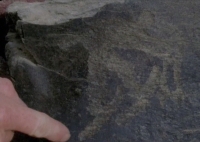I just thought to a drifting snowflake, “You’re a long way from home, little evaporated drop of seawater,” and in my mind I traced its path ahead. It would come to rest in a puff of fresh powder before blowing into the hardpack crust of a snowdrift sometime early tomorrow morning. Warm weekend weather would begin the melting process, but because of the drift’s density and the many layers of the drop’s compatriots above and below, our little drop wouldn’t thaw for two full weeks.
Finally finding its way to soil, our drop would continue downward to the water table even as its fellows are gathered up by plant roots to undergo the process of photosynthesis, respiration, and evaporation. Right here, just shy of the Continental Divide, those fellow drops would travel no further than the day winds carry their vapor, waking as morning dew to begin another day right in this very vicinity.
Our drop, however, feels the pull of gravity and the call of Mother Ocean, joining an underground railroad of similarly zombied drops, marching in steady percolation till they meet in flows and work their way ever downward through springs then streams then rivers and eventually the Golfo de California to Madre Pacifica. And there, of course, they will swim a while in the world’s largest gathering of their types. Then, one day, while lazing about the surface on a hot day, they will be whisked up into sea air and blown back inland toward these mountains which will gather them back up again as snow.
Of course water has no home. Each drop is one of the immortal Bedouins of the hydrologic cycle. Roaming the shifting sands of climate and ecology, they course their way through plants, geology, space, and time: blind hikers with no destination.
When alone in their travels, they are mostly silent, except for occasional soliloquies when they drop into a larger body of water or drip to hard earth from a ledge above. When joined by fellows, they find voice now and then, from the collective sigh of a mountain brook to the thrill of river currents crashing down the bank. And it is in the rare waterfall that our waterdrop feels a rush of gravity and community it has not felt since riding the waves back on Mother Ocean. Out there it was all moon-pull, wind spray, and current, amid a teeming highway of fellow drops; here in the seconds of the waterfall’s rush it’s a skydive of adrenaline, a rollercoaster of droplets who don’t scream till the bottom.

I’m reminded, somehow, of a petroglyph caught by the Warren Miller cameras somewhere deep in China for this year’s ski epic. The film suggests the region they visited in the Altai Mountains may be the new “cradle of skiing” (details in the second half of this 22-min. TV show, scripted by yours truly). To me, that petroglyph is evidence that humans, like snowflakes, have been making their way earthward in graceful arcs ever since we were nomads.
I’ll leave the archaeology to, ahem, archaeologists, but as I watch these thousands— no, millions— of crystalline adventurers out my window, I’m feeling the itch of my own ancestral petroglyphs.
Follow one flake and you see the industrious path of a worker bee, a route— even if it wanders— from one place to another. Soften your focus and you see flocks, shifting like sparrows, influenced by wind and gravity and physics and whim. It becomes less about getting from one place to another and it is then that I feel the way of the Bedouin pecked into my own DNA.
In other words, we are all flakes. Thanks for reading. Cheers,
![]()
Photos: by SteamboatDigs and courtesy of Warren Miller Entertainment